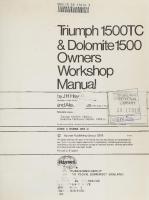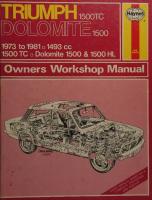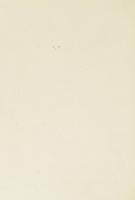Haynes Triumph 1300 & 1500 Owners Handbook/Maintenance Manual 0900550775, 9780900550775
“110 pages : 24 cm Includes index”.
140 57
English Pages 104 Year 1973
Recommend Papers
File loading please wait...
Citation preview
ee
Ss
a
( beams oy D.LY.
Owner 'S Handbook’ Maintenance Manual
_
SERVICE
areroveo ano recommenoen -
TRUMP 1300 104 @
Routine Maintenance 0 MOTPreparationo Fault Findingo Repairs S
by B.L. Chalmers-Hunt
"= SEP 1983 AUTHOR
CLASS No.
.
CHALMERS - HUNT
CAW OAce , This
book
143
swnir,
2
&e-
a
Teo pe
hondbeok
must be returned on or before the date shown to the Library from which it was borrowed
LANCASHIRE COUNTY LIBRARY CORPORATION STREET, PRESTON, PR1
CIN UN a3Q1
ZL
363364
8RH
above
Vas
Digitized by the Internet Archive in 2022 with funding from Kahle/Austin Foundation
httos://archive.org/details/triumph13001500c0000chal
Triumph 300& 100 Covers models 1965 onwards
Owners Handbook/Maintenance Manual by B. L. Chalmers-Hunt
HAYNES
75p
(387402
Cox
Acknowledgements Thanks are due to many people for their help and enthusiasm in the production of this handbook. Further thanks are extended to the manufacturer of the Triumph 1300 and 1500 for the use of certain illustrations and to Castrol Limited. A Handbook in the Haynes Owners Handbook and Maintenance Manual Series.
Edited by Tim Parker and Stanley Randolph ©
JH Haynes and Company
Limited 1973
Published by J H Haynes and Company Sparkford, Yeovil, Somerset.
Set in 10 point IBM Univers Medium Printed in England SBN no
900550
77
5
Limited,
Contents Introduction
5
Model Identification
7
Specifications, Dimensions, Capacities, Weights
11
Road Test Data
15
Spares and Touring Pack
17
Tools
19
Routine Maintenance
21
Bodywork - Maintenance, Cleaning, Minor Repairs
43
Preparing your Car for the MOT Test
53
Buying and Selling a Used Triumph
1300/1500
57
Wiring Diagrams
66
Metric Conversion Tables
73
Fault Finding Charts
77
Index
109
TRIUMPH
1300 TC
Introduction This handbook has a specific purpose — to the owner or prospective owner of a Triumph 1300/1500 enough about the car so that it may be regularly and correctly serviced with the minimum of effort, thereby giving economical trouble-free transport. It will also indicate what to do to get the car going again should it fail especially when a long way from home. These models have been in production since 1965 (1500 since 1970) and are therefore available on the second hand market at reasonably low prices. As the purchase of a cheaper car is usually due to economic necessity it follows that garage servicing bills are equally to be avoided. The reader will find in this handbook all rountine maintenance tasks that are required to keep the car running well together with a list of the tools to do the job. Most Triumph 1300 and 1500 models are now subject to the yearly MOT test; details of what the tester will be looking for, how to check these points, and the remedy of any faults are also given in this book. Motorists reading this introduction will have had the unpleasant experiences at some time of having a car that for some reason or other simply ‘dies’ or just ‘will not go’. Much of the work involved in looking after a car depends on accurate fault diagnosis in the first place. A comprehensive, methodical and progressive way of fault finding is therefore presented in this book. A great deal of time can be wasted in passing from one possible source of trouble to another. It is best and usually quicker to say at the start — ‘This could be one of serveral things - let’s get the book out’. A considerable number of motorists worry about the state of their car, particularly when it has cost hundreds of pounds. We hope this handbook will help alleviate most of this worry by giving a prospective owner an idea of the condition of the car about to be purchased and what is required to keep it from causing worry during ownership. After successfully using this handbook, should you wish to tackle the more complicated type of repair a most useful Owner's Workshop Manual is available on Triumph 1300 and 1500 models and is obtainable direct from the publishers or through all good accessory shops and booksellers. tell
Model identification In October of 1965 the Triumph 1300 now heralded at its introduction as an advanced family saloon even though it did not actually appear for sale until early in 1966. It was designed as a smaller version of the ‘de luxe’ Triumph 2000 - or small car with ‘big car’ appointments. It featured front wheel drive with an integral engine, transmission and final drive, encased as a unit. The engine was basically that of the Triumph Spitfire, mounted in the conventional position, sitting on top of the gearbox and final drive. Two short drive shafts extended either side of the engine to drive the front wheels. Independent front and rear ‘suspension was used, as were disc brakes on the front wheels and drums on the rear. It was a 4 door saloon, lavishly equipped inside, with a large boot. Several special features were included which are normally only seen on larger, more expensive cars — adjustable steering column, ventilated upholstery, recessed window winders and door handles and a unique ‘all in one dial’ instrument panel. The Triumph 1300TC appeared in October 1967 and was produced alongside the 1300. This was simply an increased performance version of the same saloon, distinguished by “TC’ badges on the rear and front side wings, having twin carburettors, a raised compression ratio, a modified crankshaft forging, a new camshaft and servo assisted braking system. Upon the Triumph model range rationalisation within the BLMC group, the 1300 models were discontinued in late 1970 to be replaced by a similarly styled but mechanically different Triumph Toledo (not dealt with here) and a ‘stretched’ version of the 1300, the Triumph 1500. The Triumph 1500 is still front wheel drive but with a larger stroke engine and a non-independent rear suspension using a ‘dead’ beam axle. Both bodily and mechanically similar to the earlier models, the 1500 is distinguishable by having a longer nose and a divided radiator grille with a ‘1500’ badge in the centre and an extended boot.
Jana} YOIIMS 4J9}4e1Ss UO!IUB}
Buliaais ULUN{OS |01}U09qou jeped ayeig jepad s0,e1aja00V7 ]O4}UOD aseajas JaUUOgG YOUMS JadIM UsaIDSPUIN JaYyseM ]O42U09 UaasJOSPUI/\ jUaWNJJsU! BUO-Ul-9adY| sojyesipul dwe| Jajsnjo Buruseny Ja}awWopaeds
J91e/\
youms 6ulzyb1) saiseyy $]01]U09 Ja}ea} YOLIMS JOLOW Ja}ea}
s}UaWINI}sUI
YO1IMs 1YyHI7 4079a]/aS JooY 1461] youms
‘s}O1]UOD
HNMTOON OO
yoin|D jepad
pUe
}O42U09
- ssoledIPUI
UO!ID94IG JOVEDIPU! {O4JUO0D usOH Jeq WIYUSIead Jana] Huljjaoued Ja}aWUOpaads }O42U09 did}
ye]sOaYyJ UO!JEUIWN||! e19e4
ayeiqpuey BAILA
aYOUD
OOEL
]O42UO9
japouw
ax0YUD {012U09
431461 |-1e619
‘JO4WUOD
Jana] ayesqpuey
sjUaUINJysU!
Vice
Cee
oe
YoUIMs UO!eUIqWOD, dwejs Juawysn[pe uWNjod Bulsaaig ]01}U09 aseajas JaUUOgG jepad 10 e1aja00V/ jeped ayeig
YouiMs 1461|-49eq pareay{
Bulsaais pue YoIMs Jaj4e}s UO!TIUBY ]042U09 4aYyseM Pue JadIM UaalISPUI\)
1UAA 41e Ysai4 4a}Sn|d JUaWUNIISU| 4a3sn|o 1461) Buruseny jaued |O1}U09 Ja}ea}y
yejsOays UO!eUIWWN]|! JUBWNIIsU|
pue
J9]NO JajeaYy UO!LIAIIP ajqelue/
- sso}Jedipul
oO
Jajseyy Buljyb1| youms
yoiniD jepad
Ja}awopaeds
Jeasy 101Da]as 49Aa|
oo
KHNMTOONO
ey
ww)
\
OOGL
sjapow
10
KS
WOR
Z
ZZ Z Zz
TD Y/
os
Under-bonnet views (left) (right) 1300 1500 —
Ro
‘Jy Nal «SG‘S$G
PSA,
(WS
Specifications, dimensions, weights, capacities Engine Type Bore Stroke: 1300 1500 Cubic capacity: 1300 1500 Compression ratio: 1300 and 1500 1300 TC Maximum bhp: 1300 1300 TC 1500 Maximum torque: 1300 1300 TC 1500 Firing order Valve clearances (cold) Sump capacity with filter Type of oil Cooling system Type
4 cylinder in line pushrod operated (ohv) 73.7 mm (2.9 in) 76 mm (2.99 mm) 87.5 mm (3.44 in)
1246 cc (79.2 cu in) 1493 cc (91 cu in) 8.5:1 924
61 at 5000 rpm 75 at 6000 rpm 61 at 5000 rpm
72.91 |b ft (10.079 kg m) at 3000 rpm 75 Ib ft (10.2 kg m) at 4000 rpm 81 Ib ft (11.198 kg m) at 2700 rpm 13s 4e2: 0.01 in (0.25 mm) 6.25 pints (3.5 litres) Castrol GTX
Pressurised radiator, thermo-syphon pump assisted and fan cooled
Coolant capacity (with heater)
1300 1500 Blow off pressure of radiator cap: 1300 prior to commission no.RD59522 1300 and 1500 after commission no.RD59522 Fan
6.25 pints (3.5 litres) 8.5 pints (4.84 litres)
7 |b/sq in (0.49 kg cm2)
13 Ib/sq in (0.91 kg cm2)
4 blades, 12.5 in (31.65 cm) diameter
Fuel system Tank capacity: 1300 1500 Carburettors: 1300 and 1500 1300 TC Fuel pump
11.75 gallons (53.4 litres)
12.5
gallons (57
litres)
Zenith Stromberg 150 CD SU HS2 or HS4 A.C. mechanical driven from camshaft
12
Specifications, dimensions, weights and capacities
Ignition system Distributor type Contact points gap Static ignition timing:
Single carburettor Twin carburettor Spark plugs
Plug gap Clutch Type Actuation Diameter: 1300 1500 Gearbox Oil capacity Gearbox oil Ratios: First Second Third Top Reverse Final Drive Location Oil capacity Final drive oil Ratios: 1300 1500
Lucas 25D4 0.005 in (0.381 mm)
9° BTDC 6° BTDC Champion N-9Y or AC Delco 45XLS (14 mm) 0.025 in (0.64 mm)
Single dry plate diaphragm spring Hydraulic
6.5 in (165 mm) diameter 7.35 in (184 mm) diameter
1300 3.40 2.16 1.45 1.06 3.99
1500 3.02 1.918 1.289 0.889 3.60
Integral unit with gearbox hypoid level gears 1.25 pints (0.85 litre) Castrol Hypoy
and
engine-
4.11: 1 4.55< 1
Overall gear ratio Overall gear ratios may be calculated by the use of the following formula: Gear ratio X rear axle ratio = overall gear ratio
Steering Type Turning circle Steering rack oil capacity Steering rack oil Suspension Front
Alford and Adler rack and pinion 33 ft (10.06 m) approx. 0.25 pint (0.15 litre) Castrol Hypoy
Independent,
double
wishbones
springs Rear: 1300
1500 Shock absorbers
Independent, springs
semi-trailing
and coil
arms, and coil
Beam axle, non-independentt, trailing links and coil springs Telescopic, hydraulic
Specifications, dimensions, weights and capacities Wheels and Tyres Wheels Rim size Type: 1300 1500
13
Steel disc type, 4 stud fitting 13 in (330 mm) 4S section Dunlop C41 Dunlop D75
Pressures:
Front Rear
-
1300 1500 1300 1500
22 26 22 26
|b/sq |b/sq |Ib/sq |Ib/sq
in (1.55 kg/sq cm) in (1.83 kg/sq cm) in* (1.55 kg/sq cm) in (1.83 kg/sq cm)
“Rear pressure to be increased by 4 Ib/sq in (0.28 kg/sq cm) in the fully laden condition to provide optimum ride. NOTE: The recommended pressures should be taken when the tyre is cold, as a hot tyre normally shows a higher pressure. Brakes
Type Footbrake Handbrake Front brakes: Disc diameter Rear brakes: Size:
1300 1500 Disc brake details: Minimum pad lining thickness Maximum disc run out Disc pad material Front pad lining area Front swept area: 1300 1500 Drum brake details:
Rear lining area Shoe lining material Minimum lining thickness Rear swept area: 1300 1500 Adjustment: 1300 1500
Girling hydraulic, disc at front, drum at rear Hydraulic on all four wheels Mechanical to rear wheels only 8.75 in (222 mm)
8 x 1.25 in (203.2 x 3.175 mm) 8x1.5 in (203.2 x 3.81 mm) 0.125 in (3.18 mm) 0.002 to 0.004 in (0.0508 to 0.1016 mm) Don 212 14.8 sq in (955 sq cm)
145 sq in (9350 sq cm) 165 sq in (10650 sq cm) 38 sq in (2450 sq cm) Don 24 0.0625 in (1.588 mm)
63 sq in (4060 sq cm) 75.5 sq in (4870 sq cm) Manually operated adjuster Self adjusting mechanism
Electrical system Battery Earthed terminal Dynamo (1300) Alternator (1500) Control box (1300) Fuses
12 volt lead acid Negative (—) Lucas C40—1 Lucas 15 ACR Lucas RB 340 2 mounted on bulkhead
Bulbs 1300 models: Headlamps (sealed beam)
60/45
14
Specifications, dimensions, weights and capacities Side parking Front direction indicator Rear direction indicator Stop Warning light cluster Roof lamp Number plate light Instrument illumination
6 21 21 6/21 Us 6 5 Dee)
1500 models: Front parking Front flasher Rear flasher
5 21 21 5/21 21 5 22 6 22 1.5 2.2 5.75 in (146.05 mm)
Tail/stop Reverse Number plate light Luggage boot illumination Roof lamp Instrument illumination Warning light cluster Cigarette lighter illumination Headlight - diameter Dimensions: Wheelbase - 1300 - 1500 Length - 1300 - 1500 Width - 1300 - 1500 Height - 1300 - 1500 Ground clearance - 1300 - 1500 Weights: Dry Kerb Max. gross vehicle weight
8 ft 0.625 in (245.4 cm) 8 ft 0.625 in (245.4 cm) 12 ft 11 in (393.7 cm) 13 ft 6 in (411 cm) 5 ft 1.75 in (156.8 cm) 5 ft 1.75 in (156.8 cm) 4 ft 6 in (132.7 cm) 4 ft 6 in (132.7 cm) 5.5 in (14 cm) 5.5 in (14 cm) 1300 1500 17 cwt (843 kg) 18 cwt (915 kg) 18 cwt (914 kg) 19 cwt (965 kg) 23.25 cwt (118 kg) 26 cwt (1315 kg)
q Master lighting switch 1500
(= x" * =
=
A
Horns
B_
Headlights main
beam lever C Headlights flashing lever D Master switch L and R - Direction indicators
Steering column adjustment clamp - 1500
Road test data 1300TC 90
Maximum speed (mph) Cruising speed (mph) Cruising range (miles) Maximum speed in gears: 3rd 2nd 1st Acceleration through gears (secs) 0-30 0-40 0-50 0-60 0-70
mph mph mph mph mph
Standing start % mile (secs) Average fuel consumption (mpg) Fuel consumption at steady 50 mph (mpg)
16
Oil filler cap
Rocker cover
x
= SS
Cylinder head
Distributor adaptor
Rear engine plate
Cylinder block
Timing cover
Distributor drive shaft bush
Generator support bracket
“S
.
.
Oil pressure switch
Rear main bearing cap Soak
Se
\
ye
Z Timing chain tensioner
Oil pump Main bearing shells Front main bearing cap
Centre main bearing cap Oil pressure release valve
Cylinder head and block fixed parts
Spares and touring pack Before undertaking any long journey, whether in this country or abroad it is advisable to thoroughly check your car and its contents. It is better to have the car serviced in good time so that any maladjustments may be corrected. Breakdown services, accredited dealers and spare part availability for Triumph 1300 and 1500 models are not always there when they are needed particularly abroad and in outlying districts of Great Britain. There are two lists, one giving spares which should always be carried in the car and the other suggesting those which it is advisable to carry if undertaking a journey abroad. Some dealers are able to supply manufacturers recommended touring packs on a hire/buy-if-y ou-use-basis. Always Carry First aid box and manual Spare set of keys
Gallon can of petrol with filler spout (full) List of Triumph main agents Breakdown triangle (compulsory on the continent) Torch (with red flashing dome) Fan belt Finilec puncture sealer Roll of PVC insulation tape Temporary plastic windscreen Length of electric cable (heavy duty lighting circuit) Screwdriver (medium sized) Electrical screwdriver
Pair of pliers Adjustable spanner (parrot jaw) Distributor - rotor arm Distributor - condenser Distributor - set of points 1 tin of hand cleanser (Swarfega)
Going abroad The articles in the ‘Always carry’ list Tow rope Set of light bulbs Set of spark plugs - clean and correctly
gapped Inner tube and set of valves Set of radiator hoses Radiator sealer (Holts Radweld) Set of fuses Length of HT lead Fire extinguisher Tube of gasket jointing cement Tin of Castrol Girling Brake Fluid 1 quart tin of Catrol GTX 1 spare head gasket set Selection of tools Adequate set of maps List of Triumph agents abroad.
Always produce
keep this handbook
in the car and
it
down
if
you
break
abroad.
Non-English speaking mechanics will find valuable information about your ‘strange’ car in it. There are many mechanical terms common to differing languages — you can always point at the photographs, it may help!
18 Rocker (L.H.)
Rocker (R.H.)
Valve collet
-&]
Valve guide ine
Valve spring 4
=
& Timi
iming
hal
chain
Rocker
ocker
aditeten
adjuster
|
Valve guide (exhaust)
Rockenenarn
Rocker
sha
Valve (exhaust)
Push rod
Valve inlet)
|
i
___
Camshaft sprocket
Gudgeon pin Driving gear shaft Compression ring Tapered ring
Distributor driving gear
Oil scraper ring Piston
Connecting rod Bearing shell (big end)
Gear carrier
Crankshaft sprocket
8
os
°s
@»
J
9
of) |
Hub
Ring gear
Bearing shell (big end)
Crankshaft
Cylinder head and block internal components
Flywheel
Tools Routine Maintenance work requires a variety of tools to carry out successfully. Most motorists have pliers and screwdrivers, but certain other tools will need to be acquired for special tasks. Buy good tools. Cheap ones do not last and can be dangerous. Sufficient tools are listed below to cover the maintenance tasks described. Open ended spanners,sizes: 5/16 AF 3/8AF 7/16AF 1/2AF 9/16AF 1 Adjustable spanner - parrot jaw 10 inch 1 Spark plug spanner 1 Pair pliers 1 Screwdriver - medium 8 inch 1 Screwdriver - crosshead 8 inch 1 Set feeler gauges 1 Brake adjusting spanner 1 Fine file - small
1 1 1 1
Engineer’s hammer (1lb ball pein) Soft headed hammer Oil can (Castrol Everyman) Grease gun (Castrol LM Grease) Clean, non fluffy cloth Overalls Hand cleanser (Swarfega)
0091/S9/ WY !W
OOP/SE} W> !W
40
9¢
Sy1UOW
OOOE /S?/!W 1
0000 WW 9
SYLUOW OOObZ /S9/!W 0000 W>
7 10
0000Z/S9 W> 1!44
SYUOW ODOT
SYUOW OOOY L/S91!\U 0000 WY
uwniny yorea 4eaA
Aly.Uuo| OOOL
A290 OGZ
JBAsa}U]
Z] 40 L
9 40
40
40
A\ieq
8dIAIaS
Bones91qe}]
6/erz LINO Zk vlsst Si
ayenaoua ay} y y40MAPO pue g Bulueal9 pue soul) sureday
Ove.
yOINb yDaYyd UO
‘6E ‘Ov Lv
‘sayeig
sabed
7191
LECOE
GIG
12.02 Co £.
EUSVG
‘410mMApog
Sa4A}
Buimoj|o}
Buliaays pue
JOlJa}U! se Pal!eyap u! sajdeyD SnidBE
‘s}y61|
adueuajzul syse] eyy SSC} pajleyap ul ay}
Ot LC BOC 6z “08 le Ze Ee PS. SE
cv
9
eI
Asseyinoe
Asessaoapy Saquuinyy d}eja1 0}
‘aoueuajule|\
20
Routine maintenance No matter how well you look after your car various Components are going to wear out and need replacement but by carrying out the regular maintenance tasks listed below, you will be able to get above average mileage from your car before replacement becomes a necessity. A great many of the maintenance tasks are purely a visual examination of componenis, many are vital to the road-worthiness of the car and safety of its occupants. The whole business of routine maintenance may become a bit tedious at times but do not neglect anything; your life Or some innocent party’s life may depend on it and your car will appreciate the care you bestow on it by giving you virtually trouble free transport.
Plan ahead Before starting work always read through what work is involved and make sure you have all the parts and lubricants that will be required. Most do-it-yourself motorists do their work during the evenings or weekends when the parts departments of garages are closed and nothing is more annoying than starting a job and being unable to complete it due to lack of spares.
Weekly or every 250 miles (400 Km) 1
Under the bonnet. Check the oil level in the sump. The first reading taken on the dipstick should not be accepted as an accurate one. Wipe it clean and recheck.
Top up if necessary with Castrol GTX.
Check the radiator coolant level in the translucent plastic reservoir and top up if necessary. If the level has dropped appreciably since the previous occasion check around for signs of a leak. If anti-freeze is in the coolant a leak will be more apparent as the coloured anti-freeze will be sprayed about by the fan. Check the level of the electrolyte in the battery and top up with distilled water if this is
low. Do not overfill. If the battery is overfilled or any electrolyte spilled, immediately wipe away the excess as electrolyte, being a dilute solution of sulphuric acid, will attack and corrode any metal it comes into contact with. Check that the terminals are clean, secure, and coated with a petroleum jelly such as vaseline to prevent corrosion.
2
Steering. Check the tyre pressures which are listed in the Specifications earlier in this book. Do not forget to check the spare. Examine the tyres for unusual or excessive wear or damage. If an unusual wear pattern is developing take your car to your local garage to have the steering geometry and suspension checked. Check that the steering is smooth and accurate. If the steering pulls one way or there is excessive play at the steering wheel take the car to your local garage for testing. 3
Brakes. Check the level of the hydraulic fluid in the reservoir and top up with Castrol Girling Brake Fluid if necessary. If the level has dropped significantly examine the braking system for possible leaks.
4
Lights. Check that all bulbs in the lights are in working order, including the flasher bulbs and brake lights. If any of the bulbs are found to be defective they can be replaced in the following manner:
Headlight sealed beam unit. 1300 models: Remove the screw located at the bottom of the rim and with a wide blade screwdriver carefully prise away the rim from the wing. Undo and remove the three screws which hold the inner rim to the seating rim and lift away the inner rim. Carefully draw the sealed beam unit
22
Engine oil dipstick
Hydraulic fluid reservoirs 1
Topping up battery electrolyte
Brake
3S
Clutch
Headlamp sealed beam unit (1300) 1, 2, 3, Retaining screws.
Tyre pressure check
2
A, B, Adjustment screws
Disconnecting the sealed beam unit (1300)
Routine maintenance 1
forwards until the connector is exposed and dis-
SY a at 7) iy yi
ks
9
resi
23
Peis wy \ci










